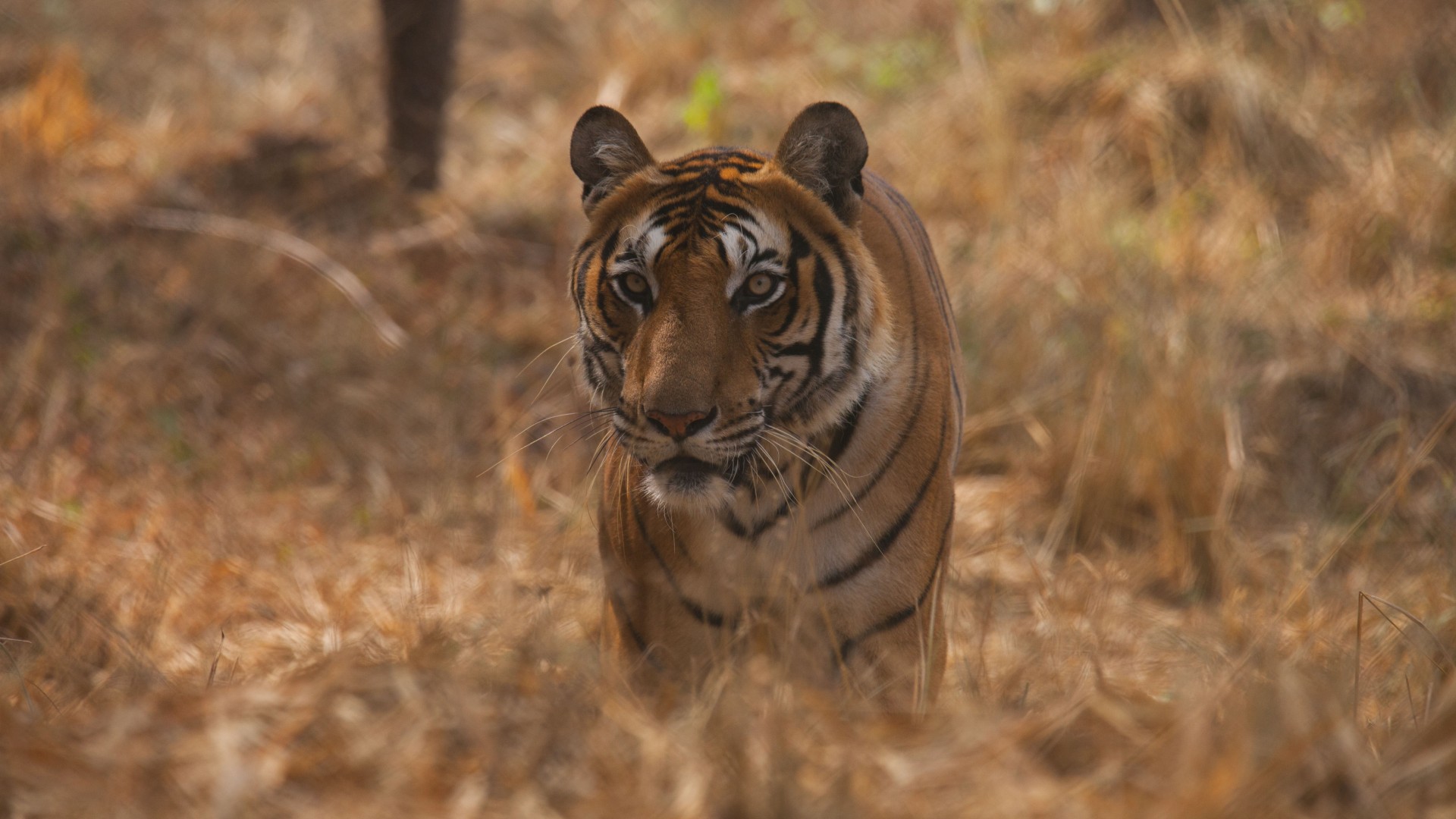23 fun facts about tigers
From the size of their teeth to the truth about white tigers, find out everything you need to know about this majestic big cat.

(c) Wildlife SOS, Lenu Kannan
1. A tiger’s stripes are unique, like human fingerprints
No two tigers have the same pattern. As the common saying goes, ‘a tiger cannot change its stripes’– and this turns out to be true! When tigers have been poached and their skins recovered, researchers have been able to trace where the tiger was poached from using camera trap records.
2. Which is bigger, a tiger or a lion?
Turns out, it depends on the individual! Tigers can be bigger than lions, however, there are 6 subspecies of tiger and while some are larger than lions, others can be smaller. The Sumatran tiger is the smallest subspecies of tiger, with females weighing up to 110kg and males 140kg. Whereas female lions can weigh up to 180kg and males up to 250kg. The Amur tiger is the biggest subspecies of tiger with females reaching weights of 167kg, and males an impressive 300kg and over 3m long!
3. A group of tigers is called an “ambush” or a “streak”
A “streak” usually refers to a mother and her offspring while an “ambush” is a group of adult tigers. Despite having a collective name, tigers are usually solitary. Female tiger home ranges rarely overlap, while a male’s home range can overlap with those of 1-3 females.
4. A tiger’s home range can be as big as 1000km2
That’s almost double the size of the Isle of Man! The amount of prey available influences the size of a tiger’s home range. Where prey is plentiful, home ranges can be as small as 7km2 while the biggest home ranges have been recorded in Far East Russia where prey is scarce. Close to the area covered by our Satpuda Landscape Tiger Partnership in Central India, a study found a female tiger’s home range was around 46km2 while a male tiger’s home range was triple the size, approximately 180km2.
5. Tigers are excellent at jumping
Tigers have shorter front legs compared to a lion, while their back legs are similar in size. These proportionally shorter front legs make a tiger better at jumping and leaping than a lion. They can jump roughly 5-6m, or even more!
6. A tiger’s roar can be heard from up to 3 km away.
The long-distance roar appears to be a tiger’s most common vocalisation and is thought to be used to signify an individual’s presence. The ability to roar is unique to species of the Panthera genus (tiger, lion, leopard, jaguar and snow leopard).
7. There are more tigers in captivity in China than in the wild worldwide
It is estimated that around 6,000 tigers are held in captivity in China, across more than 200 facilities. Many of these individuals are kept in tiger farms where they are bred, typically in appalling conditions, to supply the demand of medicinal and ornamental tiger products.
8. The largest tiger zoo enclosure is 700 times smaller than even the smallest tiger home range
Measuring 7km2, the smallest tiger home range recorded is still the size of Gibraltar! A tiger living in captivity in an enclosure measuring 0.01km2 cannot live a natural and healthy life. Read our report about why captivity is unsuitable for big cats.
9. A tiger’s night vision is six times better than a human’s
This is because they have more rods than cones in their retinas. Rods help to distinguish shapes while cones are for colour vision. As tigers are nocturnal and usually hunt during the night, they need to be better at distinguishing shapes and have less need for colour vision. Tigers are able to detect the slightest movement in low light and this helps them to track down prey.
10. The tiger is the national animal of India, Bangladesh, Malaysia, and South Korea
The Asiatic lion was previously the national animal of India but was replaced by the Bengal Tiger in 1972. The tiger was chosen because of its grace, power, agility and international significance.
11. White tigers are not a separate subspecies – they’re Bengal tigers with a genetic mutation
White tigers are lacking pheomelanin – the substance that normally gives tigers their orange colour – and therefore have white fur between the sepia-brown stripes. This mutation occurs very rarely in the wild, however, the popularity of white tigers in zoos and other captive situations has led to captive tigers being inbred to produce more white tigers. Individuals often suffer from health issues as a result of this inbreeding.
12. Tigers can eat up to 60 pounds (27 kg) of meat in one night
Tigers prefer prey that are a similar weight to themselves, however, they can hunt animals much larger such as water buffalo or gaur. Occasionally, they will even hunt Asian elephants or rhinos.
13. Unlike most cats, tigers love water and are excellent swimmers
In the Sundarbans, Bangladesh, tigers have been recorded crossing water bodies regularly, with some crossings as long as 1.5km.
14. A tiger’s canine teeth can grow up to 4 inches (10 cm) long
Tigers use their canines when hunting to deliver the kill bite to prey. Their canines are so strong, they have even been found to be able to pierce the skull of a buffalo.
15. Tiger cubs are born blind
They only open their eyes about a week after birth. Tiger cubs live in a den until they are ready to start venturing out with their mother. If mum feels that the den has been discovered, she will move the cubs to a new secret den for their protection. A tiger will usually have between 2-4 cubs at a time.
16. The word “tiger” comes from the Greek word ‘tigris’
The word ‘tigris’ is probably derived from a similar Persian word, which means arrow, possibly referring to the animal’s speed.
17. There used to be 9 subspecies of tiger, however, three went extinct in the 20th century
The Javan, Bali and Caspian Tigers are now extinct, and the South-China tiger is thought to be extinct in the wild, with the remaining population only living in zoos.
18. The estimated number of tigers living in the wild is between 3,726 and 5,578
Extensive efforts are needed to protect and conserve this remaining population and when conservation measures are effective, tiger populations can rise. In India, thanks to extensive conservation efforts, the tiger population grew from an estimated 1411 individuals in 2006 to 3,682 in 2022. Around 1,100 tigers live in Central India, where Born Free supports the Satpuda Landscape Tiger Partnership.
19. Tigers are currently found in 10 countries
These are Bangladesh, Bhutan, China, India, Indonesia, Malaysia, Myanmar, Nepal, Russia, and Thailand.
20. Tigers live in a range of habitats
As a species, tigers are habitat generalists, while each sub-species has adapted to the distinct environment of the geographical region they are found in. Tigers can be found from equatorial forests and mangroves to semi-arid landscapes, to temperate forests. They have even been found to live at elevations of 4,500m. That’s the same height as the Matterhorn in the Pennine Alps of Europe!
21. To mark their territories, tigers use a method called scent-marking
This can involve spraying urine, clawing or cheek-rubbing trees. Some tigers even have a preference for the tree species that they use to mark their territory. By scent-marking, tigers are letting other tigers know they are there, and that the area is already occupied.
22. Tiger and lion ranges used to overlap significantly
Despite often being viewed as living in very different parts of the world now, tiger and lion ranges overlapped for millennia. Having different habitat preferences is likely the reason they were able to co-habit.
23. A tiger’s stripes are actually a form of camouflage!
The stripes are an example of disruptive colouration. This is where the stripes on an animal’s fur help break up its true size and can make them appear smaller than they actually are. This helps a tiger to blend into grass or trees. Tigers hunt by ambush so this camouflage is very useful for helping them get close to their prey unseen.

ADOPT A TIGER
Adopt a tiger with Born Free today, to help support the lifetime care of Gopal and other rescued tigers, at our sanctuary in India, as well as protect tigers in the wild.
